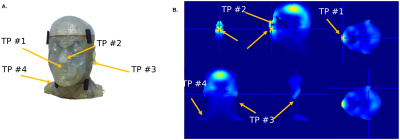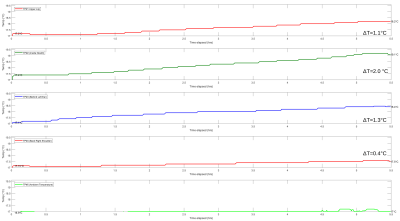4304
An electrically conductive SLA resin used for the Design of Anthropomorphic Phantoms1Bioengineering, University of Pittsburgh, Cranberry Twp, PA, United States, 2University of Pittsburgh, Pittsburgh, PA, United States, 3Bioengineering, University of Pittsburgh, Pittsburgh, PA, United States, 4Radiology, University of Pittsburgh, Pittsburgh, PA, United States
Synopsis
In this work, we have researched the possibility of using a conductive plastic that is suitable for the design of an anthropomorphic phantom for MR testing purposes. DSM Somos® provides a clear hydrophobic SLA resin that has constitutive parameters similar to the averaged electromagnetic properties of the fat, bone, and skin. The work of Wood et al.1 highlighted these findings using numerical B1 analysis. To further examine the electrically conductive plastic SLA resin material, we performed temperature testing on areas of the plastic material where we estimated temperature rise using a TEM resonator at 7T.
Synopsis
In this work, we have researched the possibility of using a conductive plastic that is suitable for the design of an anthropomorphic phantom for MR testing purposes. DSM Somos® provides a clear hydrophobic SLA resin that has conductivity similar to the averaged electromagnetic properties of the fat, bone, and skin. The work of Wood et al.1 highlighted these findings. To further examine the electrically conductive plastic SLA resin material, we performed temperature testing on areas of the plastic material where we estimated temperature rise at 7T imaging.Methods
Wood et al.1 designed a fabricated anthropomorphic head phantom. The fat, bone, and skin in the phantom is representative of SLA resin by DSM Somos® Watershed XC 11122. Using the DAK probe at ~ 297MHz, the SLA resin measures a conductivity of 0.11 (S/m) and density of 1120 (given by the spec sheet).
Numerical modeling. Using the FDTD method, a system of the anthropomorphic head phantom and TEM resonator were simulated to determine the EM fields at an operational frequency of 297.2MHz. The SAR was computed for 1 Watt of input power. The absolute SAR was assessed for local SAR spots that are on the surface of the SLA resin material.
Experimental Temperature Measurements. Using Siemens Magnetom scanner, temperature measurements were conducted with NeoptixTM temperature probes. To reach equilibrium, the phantom remained inside of the TEM resonator overnight while inside the magnet bore. The probes were strategically chosen. The probe locations are the upper lip (TP#1), the inside of the left nostril (TP#2), the back of the left ear (TP#3), the back of the right shoulder (TP#4); and in the middle of the bore for the ambient temperature (TP#5) (as shown in Figure 1).
Scanning Parameters: FID Heating sequence; TR: 3500ms; FA: 3600°; Averages: 4096; Reference Voltage: 300V TA: ~5.5hrs.
Results and Discussion
Figure 2 indicates the results of the temperature rises for all probes. The SLA resin material is considerably heating and thus, we can conclude that the phantom material is conductive. The temperature change is highest in the nasal passage with a rise of 2°C. There an equal temperature rise on the upper lip of 1.1°C and behind the ear 1.3°C. There was very little temperature rise in the shoulders. The averaged tissue in the fat, bone, and skin offer conductivity of 0.1663 and density of 1223.49. While it would be ideal to have a conductive skin layer, the SLA shows promise in being a useful tool for MR purposes.
In conclusion, the SLA resin is conductive and a useful tool to assess approximate temperature rise in mimicked human tissue. Future work will involve a more robust view of the temperature rise in additional compartments within the phantom.
Acknowledgements
The work reported in this abstract was partially supported by NIH grants: 1R01MH111265-01 and F31EB019872.References
1. Wood S, Krishnamurthy N, Santini T, et al. Design and fabrication of a realistic anthropomorphic heterogeneous head phantom for MR purposes. PLoS One. 2017;12(8).Figures

